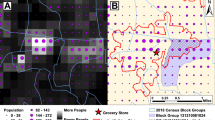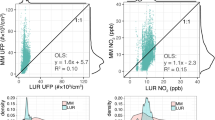Abstract
Self-reported distances to industrial sources have been used in epidemiology as proxies for exposure to environmental hazards and indicators of awareness and perception of sources. Unconventional oil and gas development (UOG) emits pollutants and has been associated with adverse health outcomes. We compared self-reported distance to the nearest UOG well to the geographic information system-calculated distance for 303 Pennsylvania, Ohio, and West Virginia residents using Cohen’s Weighted Kappa. Agreement was low (Kappa = 0.18), and self-reports by Ohioans (39% accuracy) were more accurate than West Virginians (22%) or Pennsylvanians (13%, both p < 0.05). Of the demographic characteristics studied, only educational attainment was related to reporting accuracy; residents with 12–16 years of education were more accurate (31.3% of group) than those with <12 or >16 years (both 16.7%). Understanding differences between objective and subjective measures of UOG proximity could inform studies of perceived exposures or risks and may also be relevant to adverse health effects.
Impact
We compared objective and self-reported measures of distance to the nearest UOG well for 303 Appalachian Basin residents. We found that residents’ self-reported distance to the nearest UOG well had limited agreement with the true calculated distance category. Our results can be used to inform the collection and contextualize the use of self-reported data in communities exposed to UOGD. Self-reported metrics can be used in conjunction with objective assessments and can be informative regarding how potentially exposed populations perceive environmental exposures or risks and could provide insights into awareness of distance-related policies, such as setbacks.
This is a preview of subscription content, access via your institution
Access options
Subscribe to this journal
Receive 6 print issues and online access
$259.00 per year
only $43.17 per issue
Buy this article
- Purchase on Springer Link
- Instant access to full article PDF
Prices may be subject to local taxes which are calculated during checkout


Similar content being viewed by others
Data availability
Links and references are provided for all publicly available data sources, such as oil and gas well locations. Interview data were collected from individual study participants after informed consent. IRB protocols and consent materials restrict publicly sharing individual data points. However, data are provided in aggregate form in the publication and anonymized individual-level data may be provided upon reasonable request.
References
Naska A, Lagiou A, Lagiou P. Dietary assessment methods in epidemiological research: current state of the art and future prospects. F1000Res. 2017;6:926.
Toftager M, Ekholm O, Schipperijn J, Stigsdotter U, Bentsen P, Grønbæk M, et al. Distance to green space and physical activity: a Danish national representative survey. J Phys Act Health. 2011;8:741–9.
Carter M, Horwitz P. Beyond proximity: the importance of green space useability to self-reported health. EcoHealth. 2014;11:322–32.
Hazer M, Formica MK, Dieterlen S, Morley CP. The relationship between self-reported exposure to greenspace and human stress in Baltimore, MD. Landsc Urban Plan. 2018;169:47–56.
Coulton CJ, Jennings MZ, Chan T. How big is my neighborhood? Individual and contextual effects on perceptions of neighborhood scale. Am J Community Psychol. 2013;51:140–50.
Hume C, Salmon J, Ball K. Children’s perceptions of their home and neighborhood environments, and their association with objectively measured physical activity: a qualitative and quantitative study. Health Educ Res. 2005;20:1–13.
Castelló A, Pérez-Gómez B, Lora-Pablos D, Lope V, Castaño-Vinyals G, Vitelli-Storelli F, et al. Validation of self-reported perception of proximity to industrial facilities: MCC-Spain study. Environ Int. 2020;135:105316.
Nuckols JR, Ward MH, Jarup L. Using geographic information systems for exposure assessment in environmental epidemiology studies. Environ Health Perspect. 2004;112:1007–15.
Downey L, Van Willigen M. Environmental stressors: the mental health impacts of living near industrial activity. J Health Soc Behav. 2005;46:289–305.
United States Environmental Protection Agency. The Process of Unconventional Natural Gas Production. Updated January 4, 2021. https://www.epa.gov/uog/process-unconventional-natural-gas-production.
Field RA, Soltis J, Murphy S. Air quality concerns of unconventional oil and natural gas production. Environ Sci: Process Impacts. 2014;16:954–69.
Hays J, McCawley M, Shonkoff SBC. Public health implications of environmental noise associated with unconventional oil and gas development. Sci Total Environ. 2017;580:448–56.
Ehrman MU. Overview of oil and gas wastewater injection induced seismicity in hydrocarbon regions in the United States, Canada, and Europe. In: Buono RM, López Gunn E, McKay J, Staddon C, editors. Regulating water security in unconventional oil and gas. Cham: Springer International Publishing; 2020. p. 291–305.
Graham J, Irving J, Tang X, Sellers S, Crisp J, Horwitz D, et al. Increased traffic accident rates associated with shale gas drilling in Pennsylvania. Accid Anal Prev. 2015;74:203–9.
Gorski I, Schwartz B. Environmental health concerns from unconventional natural gas development. Oxford Research Encyclopedia of Global Public Health. 2019. https://doi.org/10.1093/acrefore/9780190632366.013.44.
Gomm S, Bernauer T. Are actual and perceived environmental conditions associated with variation in mental health? Environ Res. 2023;223:115398.
Elser H, Goldman-Mellor S, Morello-Frosch R, Deziel NC, Ranjbar K, Casey JA. Petro-riskscapes and environmental distress in West Texas: community perceptions of environmental degradation, threats, and loss. Energy Res Soc Sci. 2020;70:101798.
Ferrar KJ, Kriesky J, Christen CL, Marshall LP, Malone SL, Sharma RK, et al. Assessment and longitudinal analysis of health impacts and stressors perceived to result from unconventional shale gas development in the Marcellus Shale region. Int J Occup Environ health. 2013;19:104–12.
Perry SL. Using ethnography to monitor the community health implications of onshore unconventional oil and gas developments: examples from Pennsylvania’s Marcellus Shale. New Solut. 2013;23:33–53.
Jacquet JB, Junod AN, Bugden D, Wildermuth G, Fergen JT, Jalbert K, et al. A decade of Marcellus Shale: impacts to people, policy, and culture from 2008 to 2018 in the Greater Mid-Atlantic region of the United States. Extr Ind Soc. 2018;5:596–609.
Soyer M, Kaminski K, Ziyanak S. Socio-psychological impacts of hydraulic fracturing on community health and well-being. Int J Environ Res Public Health. 2020;17:1186.
Sangaramoorthy T, Jamison AM, Boyle MD, Payne-Sturges DC, Sapkota A, Milton DK, et al. Place-based perceptions of the impacts of fracking along the Marcellus Shale. Soc Sci Med. 2016;151:27–37.
Clark CJ, Xiong B, Soriano MA Jr, Gutchess K, Siegel HG, Ryan EC, et al. Assessing unconventional oil and gas exposure in the Appalachian Basin: comparison of exposure surrogates and residential drinking water measurements. Environ Sci Technol. 2022;56:1091–103.
Jones RR, DellaValle CT, Flory AR, Nordan A, Hoppin JA, Hofmann JN, et al. Accuracy of residential geocoding in the Agricultural Health Study. Int J Health Geogr. 2014;13:37.
McHugh ML. Interrater reliability: the kappa statistic. Biochem Med (Zagreb). 2012;22:276–82.
Barton Laws M, Yeh Y, Reisner E, Stone K, Wang T, Brugge D. Gender, ethnicity and environmental risk perception revisited: the importance of residential location. J Community Health. 2015;40:948–55.
Cordioli M, Ranzi A, Freni Sterrantino A, Erspamer L, Razzini G, Ferrari U, et al. A comparison between self-reported and GIS-based proxies of residential exposure to environmental pollution in a case–control study on lung cancer. Spat Spatiotemporal Epidemiol. 2014;9:37–45.
Gunier RB, Reynolds P, Hurley SE, Yerabati S, Hertz A, Strickland P, et al. Estimating exposure to polycyclic aromatic hydrocarbons: a comparison of survey, biological monitoring, and geographic information system–based methods. Cancer Epidemiol, Biomark Prev. 2006;15:1376–81.
Turley B, Caretta MA. Household water security: an analysis of water affect in the context of hydraulic fracturing in West Virginia, Appalachia. Water. 2020;12:147.
Willow AJ. Troubling water: shale energy and waterscape transformation in a North American extraction zone. Anthropologica. 2016;58:166–78.
Swistock BR, Clemens S, Sharpe WE. Drinking water quality in rural Pennsylvania and the effect of management practices. The Center for Rural Pennsylvania: Harrisburg, PA, 2009.
Acknowledgements
This research was supported in part by the National Priority Research Project under Assistance Agreement No. CR839249 awarded by the U.S. Environmental Protection Agency (EPA) to Yale University. The publication has not been formally reviewed by EPA. The views expressed in this document are solely those of the authors and do not reflect those of the Agency. EPA does not endorse any products or commercial services mentioned in this publication. CJC was also supported by a T32 training grant from the National Cancer Institute (T32 CA250803). The content is solely the responsibility of the authors and does not represent the official views of the National Institutes of Health.
Author information
Authors and Affiliations
Contributions
CJC, NCD, DLP, and JES contributed substantially to the conception, data collection, analysis, and manuscript preparation for this work. JAC and MLB contributed substantially to the conception, analysis, and manuscript preparation for this work.
Corresponding author
Ethics declarations
Competing interests
The authors declare no competing interests.
Ethical approval
The study protocol was approved by the Institutional Review Board of Yale University (HIC #2000021809) and reviewed and approved by the US Environmental Protection Agency (HSR-001162). All participants provided informed consent prior to data collection activities.
Additional information
Publisher’s note Springer Nature remains neutral with regard to jurisdictional claims in published maps and institutional affiliations.
Supplementary information
Rights and permissions
Springer Nature or its licensor (e.g. a society or other partner) holds exclusive rights to this article under a publishing agreement with the author(s) or other rightsholder(s); author self-archiving of the accepted manuscript version of this article is solely governed by the terms of such publishing agreement and applicable law.
About this article
Cite this article
Clark, C.J., Casey, J.A., Bell, M.L. et al. Accuracy of self-reported distance to nearest unconventional oil and gas well in Pennsylvania, Ohio, and West Virginia residents and implications for exposure assessment. J Expo Sci Environ Epidemiol (2024). https://doi.org/10.1038/s41370-023-00637-8
Received:
Revised:
Accepted:
Published:
DOI: https://doi.org/10.1038/s41370-023-00637-8



